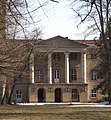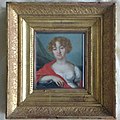Dorothea von Medem
| Dorothea von Medem | |
|---|---|
Duchess consort of Courland | |
| Tenure | 6 November 1779 – 28 March 1795 |
| Born | 3 February 1761 |
| Died | 20 August 1821 (aged 60) |
| Spouse | Peter von Biron |
| Issue | Princess Wilhelmine, Duchess of Sagan Princess Pauline, Duchess of Sagan Princess Joanna, Duchess of Acerenza Prince Peter Princess Dorothea |
| Father | Friedrich von Medem |
| Mother | Louise Charlotte von Manteuffel |
| Religion | Lutheranism |
Countess Anna Charlotte Dorothea von Medem (3 February 1761 – 20 August 1821) was born a
Biography
Anna Charlotte Dorothea was born at

Duchess of Courland
On 6 November 1779, eighteen-year-old Dorothea became the third wife of the 55-year-old, childless Duke Peter von Biron, son of the famous Ernst Johann von Biron. The couple had six children, two of whom died in infancy. The four surviving children were all daughters; however, the youngest one, Dorothea, was probably not fathered by; although recognized by the Duke.
Dorothea was welcomed into the highest social circles thanks to her new status as duchess as well as her beauty. Because her husband was preoccupied with political difficulties at home involving his
Later life
In 1794 she acquired the Gutsherrschaft
Upon her youngest daughter Dorothea's marriage to Talleyrand's nephew, Edmond de Talleyrand-Périgord, in 1809, the duchess moved to Paris, having an intense relationship with Talleyrand and influenced him to turn against Napoleon. In 1814 she traveled to the Congress of Vienna to confront him about his alleged love affair with her daughter Dorothea. A few years after her death at Löbichau in 1821, the Duchess' body was moved from her place of death to the family vault at Sagan where her husband was buried in 1800.
Issue
With Peter von Biron:
- Klemens Wenzel, Prince von Metternich
- Pauline, Duchess of Sagan and Princess of Hohenzollern-Hechingen
- Duchess of Acerenza
- Peter (23 February 1787 – 25 March 1790)
- Charlotte (21 January 1789 – 10 March 1791)
With Alexander Batowski:
- Dorothea, Duchess of Talleyrand-Périgord, Duchess of Dino, Duchess of Sagan, protégé (and alleged mistress) of Talleyrand and wife of his nephew the 2nd Duke of Talleyrand
Gallery
-
Her husband, Peter von Biron
-
Her eldest daughter, Wilhelmine
-
Her second daughter, Pauline
-
Her third daughter, Johanna
-
Her fourth daughter, Dorothea
-
Jelgava Palace, the Biron residence
-
her beloved Schloss Löbichau
-
Miniature portrait titled: Wilhelmine von Mengden .. Grafin Medem ... 1792
Bibliography
- Elisa von der Recke: Tagebücher und Selbstzeugnisse. Leipzig 1984
- Emilie von Binzer: Drei Sommer in Löbichau 1819–21. Stuttgart 1877
- Philip Ziegler: Die Herzogin von Dino, Talleyrands letzte Vertraute. München 1965
- Clemens Brühl: Die Sagan. Berlin 1941
- Sabine und Klaus Hofmann: Zwischen Metternich und Talleyrand. Der Musenhof der Herzogin von Kurland im Schloss zu Löbichau. Museum Burg Posterstein, 2004
- Christoph August Tiedge: Anna Charlotte Dorothea. Letzte Herzogin von Kurland. F. A. Brockhaus, Leipzig 1823 Online-Version at Internet Archive
Notes
- ^ Cecilia af Klercker (1936). Hedvig Elisabeth Charlottas dagbok VII 1800–1806 (The diaries of Hedvig Elizabeth Charlotte VIII 1800–1806) (in Swedish). P.A. Norstedt & Söners förlag Stockholm. pp. 270–271. 362103.
External links
 Media related to Dorothea von Medem at Wikimedia Commons
Media related to Dorothea von Medem at Wikimedia Commons- https://web.archive.org/web/20070928121332/http://www.burg-posterstein.de/startframes/historietopframe.htm








